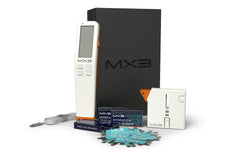News
First Exos UE Research Study Published!
Posted on:
We are excited to announce our FIRST EXOS UE STUDY was published in the August edition of Clinical Biomechanics Journal and the results support the use of the Exos thermo-formable brace clinically vs. traditional casting! This is great news for Exos, as we now have evidence that the Exos UE braces stabilize distal radius fractures in a manner that is not statistically different than traditional casting.
METHOD: A biomechanical study was conducted to examine the ability of the EXOS wrist brace to constrain severe, unstable and comminuted distal radius fractures in comparison to traditional fiberglass casting. A worst-case distal radius fracture was created in 6 cadaver forearms and the movement of the fracture fragments was analyzed using radiographic measures under various loading parameters.
CONCLUSION: The model successfully induced gross fracture fragment displacements and rotations in the non-stabilized condition with 1 lb of load applied and was verified on lateral radiographs. Stabilization successfully constrained the fracture fragments with both the Exos brace and fiberglass cast in sagittal plane rotations. This stabilization was seen at both 1 lb and 15 lbs of applied load. There were no statistically significant differences between the thermo-formable brace and the fiberglass cast.
KEY MESSAGE: This study demonstrated that both the Exos thermo-formable bracing and fiberglass casting successfully stabilized fracture fragments in severe, unstable and comminuted distal radius fractures. Therefore, the results of this study provide verification that the Exos thermo-formable braces are a viable option for treatment of these types of distal radius fractures.
METHOD: A biomechanical study was conducted to examine the ability of the EXOS wrist brace to constrain severe, unstable and comminuted distal radius fractures in comparison to traditional fiberglass casting. A worst-case distal radius fracture was created in 6 cadaver forearms and the movement of the fracture fragments was analyzed using radiographic measures under various loading parameters.
CONCLUSION: The model successfully induced gross fracture fragment displacements and rotations in the non-stabilized condition with 1 lb of load applied and was verified on lateral radiographs. Stabilization successfully constrained the fracture fragments with both the Exos brace and fiberglass cast in sagittal plane rotations. This stabilization was seen at both 1 lb and 15 lbs of applied load. There were no statistically significant differences between the thermo-formable brace and the fiberglass cast.
KEY MESSAGE: This study demonstrated that both the Exos thermo-formable bracing and fiberglass casting successfully stabilized fracture fragments in severe, unstable and comminuted distal radius fractures. Therefore, the results of this study provide verification that the Exos thermo-formable braces are a viable option for treatment of these types of distal radius fractures.
Collections
- Sales and Specials
- Infection Control & PPE
- Ankle & Foot
- Athletic Tape
- Bags, Cases & Kits
- Bandages & Wound Care
- Clinical Supplies
- Electrotherapy
- Emergency Response
- Furniture & Equipment
- Hot & Cold Therapy
- Hydration Products
- Knee & Leg
- Lumbar & Cervical
- Shoulder/Arm/Wrist
- Padding & Protective Gear
- Pharmacy
- Rehabilitation Supplies
- Tools & Instruments
From The Blog
10 Ways you can improve your Sports Medicine Bid results this summer
There are some 1,300 colleges and over 26,000 high schools in the United States who acquire sports medicine supplies and equipment, almost every year. A high percentage of those institutions...
Read MoreAthletic Training Room Furniture: Pros and Cons of Laminate vs Wood vs Steel
We're often asked for the Pros and Cons of Laminate vs Wood vs Steel Athletic Training Room and Physical Therapy tables. This article presents the pros and cons of laminate vs wood...
Read MoreREAD ALL NEWS




